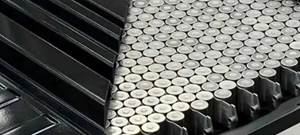Editorial - 4/1/2005
I'm writing this column from the Conference on Corrosion, Construction & Infrastructure in Las Vegas (March 8-11). I've attended this biennial event since the late '80s, when it was sponsored by the Western division of the Society of the Plastics Industry (SPI). Now under the American Composites Manufacturers
I'm writing this column from the Conference on Corrosion, Construction & Infrastructure in Las Vegas (March 8-11). I've attended this biennial event since the late '80s, when it was sponsored by the Western division of the Society of the Plastics Industry (SPI). Now under the American Composites Manufacturers Assn. (ACMA) umbrella, the event has assembled, throughout the years, knowledgeable polymer chemists and engineers from academia, material suppliers and parts manufacturers who, as a group, take on some of industry's most aggressive challenges. The winner of this year's Frank A. Cassis Award for Innovation in Corrosion Resistant Composites was inventor Norman Fawley of NCF Industries (San Luis Obispo, Calif.), who has spent a lifetime designing and creating cutting-edge industrial products using reinforced materials. A paper co-written by NCF and leading North American energy company TransCanada discussed several projects for reinforced pipe and high pressure gas transport modules (GMTs) developed by NCF, which have the potential to use literally millions of pounds of composite materials. The Conference showcased several other notable applications that represent manufacturing opportunities in corrosion-resistant structures that, together with the TransCanada project, may seriously challenge the industry's ability to meet demand.
Annual growth in several of the sectors using corrosion-resistant products already is expected to exceed the 5 percent predicted for the composites industry as a whole by Ray MacNeil, business analyst from PPG Industries (Pittsburgh, Pa.). Some manufacturers, including Martin Marietta's Grant Godwin (Raleigh, N.C.), the conference keynote speaker, feel we are nearing a pivot point where the benefits of composites finally will be realized and we may see explosive growth in the next few years! His presentation, cleverly entitled, "Reversing 200 years of Metals and Concrete Experimentation," asks why the world continues to tolerate the use in civil and industrial applications of materials so singularly ill-suited to the job at hand, when there are much better solutions readily available in composite materials. Godwin then showed a few pictures of corroded, dilapidated wooden, metal and concrete structures — and we all had a good laugh. His larger point, backed up with statistics, was that composite materials have actually come a long way since they were introduced to industrial markets in the '70s, and better times are yet to come.
While cost is always critical, manufacturers in these sectors don't face the degree of price resistance that we see in automotive and consumer products. In many applications, such as huge tanks, cooling towers, wind blades and specially designed, one-of-a-kind structures, composites may not be more expensive than the material previously used and they may provide multiple solutions to present problems as well.
Speaking of structures, our "Composites and Concrete" update in this issue of Composites Technology sheds light on lightweight concrete building panels reinforced with fiberglass mesh or chopped fiber (p. 36). These products are becoming well established in the precast concrete panel segment. We also bring you up to date on successful commercializations of nanofillers in composite resins (p. 42). While still relatively new technologies, they are already enabling composite product designers to circumvent previously unavoidable trade-offs in processing and performance properties.
We also got the exclusive story on the design and manufacture of the compression-molded SMC pickup box on Honda's new pickup truck, the Ridgeline ("Engineering Insights," p. 52). A standard feature (not an optional upgrade), the composite box sports several unusual features, not the least of which is a first-ever integral locking trunk. And since we'll soon cross the Atlantic to the JEC Show, we thought it might be a good time to take a look at "Distributors in the Composites Industry" (p. 28) and the roles they play as key international links in the global supply chain.
See you in Paris!
Related Content
Composites end markets: Batteries and fuel cells (2024)
As the number of battery and fuel cell electric vehicles (EVs) grows, so do the opportunities for composites in battery enclosures and components for fuel cells.
Read MoreDrag-based wind turbine design for higher energy capture
Claiming significantly higher power generation capacity than traditional blades, Xenecore aims to scale up its current monocoque, fan-shaped wind blades, made via compression molded carbon fiber/epoxy with I-beam ribs and microsphere structural foam.
Read MoreComposites end markets: Energy (2024)
Composites are used widely in oil/gas, wind and other renewable energy applications. Despite market challenges, growth potential and innovation for composites continue.
Read MoreInfinite Composites: Type V tanks for space, hydrogen, automotive and more
After a decade of proving its linerless, weight-saving composite tanks with NASA and more than 30 aerospace companies, this CryoSphere pioneer is scaling for growth in commercial space and sustainable transportation on Earth.
Read MoreRead Next
All-recycled, needle-punched nonwoven CFRP slashes carbon footprint of Formula 2 seat
Dallara and Tenowo collaborate to produce a race-ready Formula 2 seat using recycled carbon fiber, reducing CO2 emissions by 97.5% compared to virgin materials.
Read MorePlant tour: Daher Shap’in TechCenter and composites production plant, Saint-Aignan-de-Grandlieu, France
Co-located R&D and production advance OOA thermosets, thermoplastics, welding, recycling and digital technologies for faster processing and certification of lighter, more sustainable composites.
Read MoreVIDEO: High-volume processing for fiberglass components
Cannon Ergos, a company specializing in high-ton presses and equipment for composites fabrication and plastics processing, displayed automotive and industrial components at CAMX 2024.
Read More




.jpg;maxWidth=300;quality=90)
















